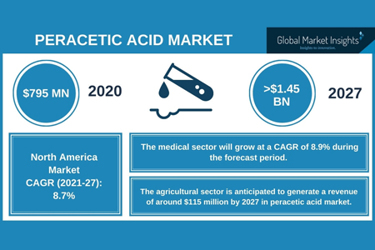Increasing Consumption Of Processed Food To Proliferate Peracetic Acid Market Demand
By Vijay Ovhal

Domestic cooking has taken a back seat across several developed economies, given the steady rise in the female workforce and subsequent lack of time. This, along with significant improvement in disposable incomes, has been playing a critical role in accelerating the shift toward processed food and beverages.
According to the U.S. Department of Agriculture:
- The total value of processed food exports from the U.S. stood at 11 metric tons, accounting for $38 billion in 2022.
- The 3-year average export value from the country stood at 34.17 billion.
These estimates point toward the flourishing cross-border trade of processed food items, which is further poised to boost the demand for peracetic acid (PAA) market, given its increasing usage as a disinfectant and cleanser in numerous food processing applications. From an industrial viewpoint, peracetic acid offers multiple advantages, ranging from its easy application to leaving no toxic residues.
What's even more appealing about the product is its no-rinse formulation and capability to function well in cold temperatures, which makes it ideal for meat processing as it requires working under freezers and coolers. These superior attributes have prompted product manufacturers globally to undertake research projects to develop new formulations and discover new ways of utilizing the product in varied food applications.
How can wastewater treatment present new growth opportunities to the solution-grade peracetic acid market?
Peracetic acid, unlike chlorine, decomposes into hydrogen peroxide and acetic acid (vinegar), which are non-carcinogenic, mutagenic, or toxic biodegradable residuals that can pass fish toxicity tests without removal. The acid usage is highly unlikely to produce harmful disinfection byproducts (DBPs) and chlorinated compounds and cause bioaccumulation. This is why PAA is deemed a potential answer to stringent DBP regulations and is an increasingly preferred compound in wastewater treatment systems.
- Around 34 billion gallons of wastewater is processed in wastewater treatment facilities in the U.S. every day.
- 20% of homes in the country utilize septic systems that locally treat their wastewater.
The remarkable growth in wastewater due to rapid population growth, urbanization, and industrial development has put forth the dire requirement for new water treatment facilities. With governments globally focusing on implementing efficient waste management practices, the demand for solution-grade PAA is set to grow substantially over the coming years.
To illustrate, in July 2022, the City of Hamilton announced the expansion of its sewage treatment facility as part of an anticipatory project intending to contain the release of solid waste into island waters. The city further declared to incorporate a peracetic acid disinfection procedure on the wastewater to lower down the levels of bacteria.
Strategic Moves — Changing The Peracetic Acid Market Growth Dynamics
The expansive application avenues of peracetic acid market, in combination with several clinical studies that point toward the efficacy of hydrogen peroxide on different types of fabric contaminated with SARS COV 2 virus, have prompted companies globally to boost their production capabilities to aid the growing product demand.
Peracetic Acid Market — A Long Way Ahead
Given its countless benefits, the product has gained widespread popularity and acceptance among the masses, and this is poised to have no look back. The agricultural industry is one of the major contributors that is expected to redefine the peracetic market outlook as the product tends to find across-the-board usage in treating and processing destined vegetables and fruits to protect them from spoilage and pathogens.
Besides, the product abides by stringent food safety regulations across many economies and is safe to be used as a disinfectant, sanitizer, and sterilizing agent in agricultural products. With agricultural production set to cross leaps and bounds, the peracetic acid industry is poised for a brighter future.
Source: https://www.gminsights.com/industry-analysis/peracetic-acid-market
